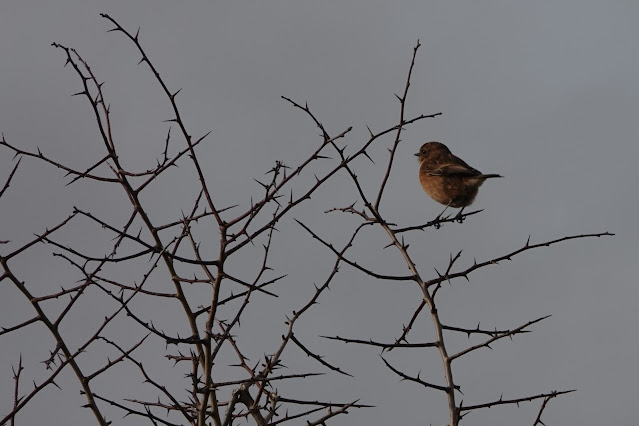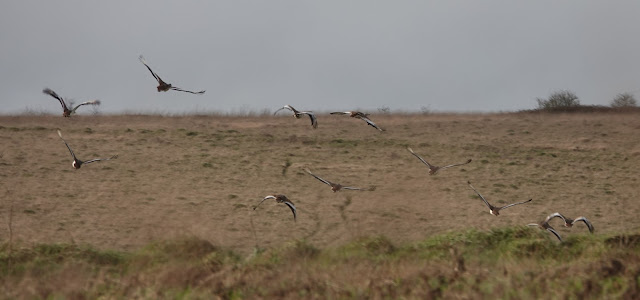6th January
The Somerset Levels beckoned for a Blue Eyed Birder Weekend and with kind traffic on the
M25 and M3 we were soon on the A303 and heading into Wiltshire. Red Kites and Buzzards had accompanied the
journey for a while by this stage before I turned off at the main Countess
roundabout and diverted up onto Salisbury Plain.
Now I have trundled around the various MoD tracks on non-Red Flag days a few times now and had no joy with the Great Bustards that are now doing so well out here so I chose a bit that I had not ventured into before. A couple of miles in I came over a rise and there, in an oilseed field in the dip below were a collection of large pale blobs standing out against the dark green. I knew immediately that I had found a drove of these magnificent birds.
.JPG) |
| Great Bustards |
I quietly parked up and got the scope out. They were about quarter of a mile away and
unconcerned by my presence. I have seen
Great Bustards a few times in Iberia over the last few years and I am always
taken aback by the power and stately nature of these powerful birds but on this
occasion the memories went back way further to a cold January 31st
in 1987 with snow still deep on the verges when I was lucky enough to be in the
right place at the right time near Kirton in Suffolk to see the last truly wild
Great Bustards in Britain. Those three
birds flying into a field opposite where my Mum, Dad and Brother were standing
is ingrained on my mind and is still a frequent mental playback request.
 |
| Happy memories from Kirton, Suffolk on January 31st in 1987 - pic by my Dad, Peter, who crawled out along the hedgeline to get a picture. |
We watched them for a few minutes, counting 21 of various
sizes before slowly driving down the hill.
A quad bike came noisily the other way and did not spook them so we were
pleased when we stopped that they continued feeding. Two Roe Deer did likewise in the adjacent
field and several Red Kites, Buzzards and Ravens were in the area.
 |
| Roe Deer |
.JPG) |
| Great Bustards |
 |
| Great Bustards |
We moved on a bit further until they dropped out of sight
over the ridge but a Buzzard flew low in their direction and suddenly they were
in the air! I pulled over and leapt out
and watched them for several minutes as they did two full circuits of the
valley bowl before landing out of view further back. A 22nd bird joined them in flight
but only caught up with hem as they touched down!
They are such powerful, majestic birds in flight and to see
them effortlessly flying over their reclaimed English home was a wondrously moving
experience. I may be one of the lucky
ones to have seen the species in the UK before the re-introduction began but I
can assure you that seeing this flock was no less satisfying. The ornithological stigma that is attached to
what birders call ‘plastic’ birds is non-sensical to me. I am in England; I am watching Great Bustards
that may well have been born in that rolling lanscape and above all I am a
birder and they are simply amazing to watch. Would I have ‘ticked’ them if they
had been my first? Absolutely – not that it inherently matters.
I continued the circuit with a huge grin picking up Stonechats,
Corn Buntings, Skylarks and a few winter Thrushes before re-joining the main
road and the route west.
 |
| Stonechat |
The next few miles added more Red Kites and several more Roe
Deer along with three each of Fallow and Red which was a nice bonus.
The roads continued to be kind and by 2pm Glastonbury was in sight so instead of dropping off the gear at the Travel Lodge I decided to head around to Ham Wall as the weather was holding and potentially looked better than either day of the weekend for my tour party. I quickly phoned the others to see if they were near but no one was around quite then so I got myself booted up and ambled firstly east onto the Shapwick section where the drake American Wigeon was quickly found tucked up on the bank in the south east corner. It was good to not have to search through a hoard of our own species to find him! He was in fine plumage and close enough to see the fine speckles across the face and neck below the green eye blaze and in the winter sunshine even that had a purplish hue on the border with the creamy white central blaze. The rest of the Hudwit Lagoon (not sure of its real name) was dotted with the usual dabblers minus Pintail and a couple of Marsh Harriers quartered.
 |
| American Wigeon - fence framed |
I retraced my
steps and crossed back to the Ham Wall side picking up Treecreeper, two
Siskins, Goldfinches, Chiffchaffs, Goldcrest and some Long-tailed Tits while a Kingfisher
zipped over the main bridge ahead of me.
Siskins and Goldfinches You would have been disappointed if I did not include some moth leaf mines - Coptotrich marginea and Stigmella aurella - both on Bramble - no leaves left on anything else!
I loafed around the main viewpoint for a while counting 80
Black-tailed Godwits amongst the throng of Lapwing. Wisps of Snipe kept randomly flying around in
groups of up to 40 and I suspect that I saw the best part of 200 birds.
A Great White Egret was firmly attached to the closest
lagoon and another and three Little Egrets were out on the main flood where
nothing seemed too phased by the constant presence of Marsh Harriers.
Great White Egret and Shoveler
Before too long the Starlings started to appear but so did a light but persistent drizzle so I did not stay too long after 4pm but it was still amazing with several hundred thousand birds heading west to a roost out of sight and tens of thousands dropping without much ceremony into the reedbed opposite where I stood.
 |
| Plummeting in |
Water Rails and Little Grebes produced their own backdrop to the ever building racket of chattering Starlings before I decided that it would be prudent to retreat for the evening and anyway we still had to check in before driving back towards Langport for dinner with Martin and Hazel Jordan - recent Essex migrants. Two calling Firecrests in the Alders before the car park were a fine way to wrap up birding proceedings.










.JPG)







Well done Howard.
ReplyDeleteMeare Heath scrape (Hudwit lagoon)
ReplyDelete